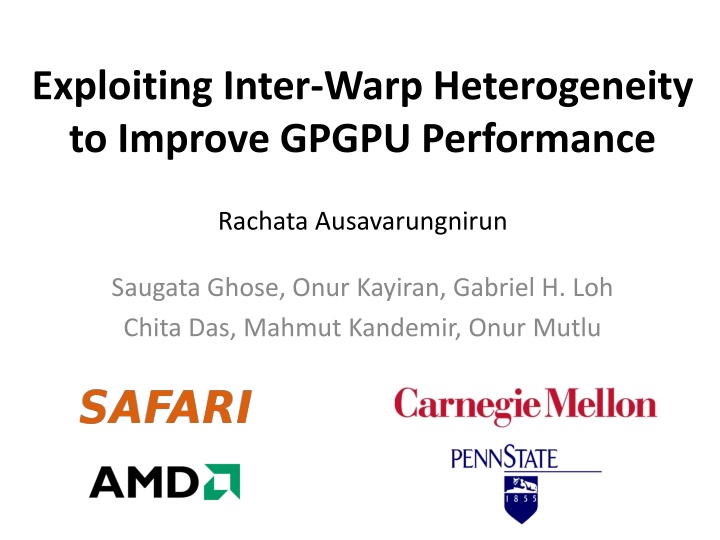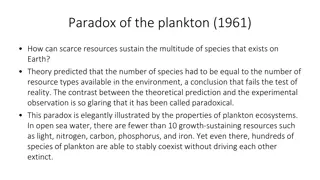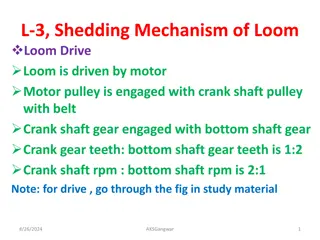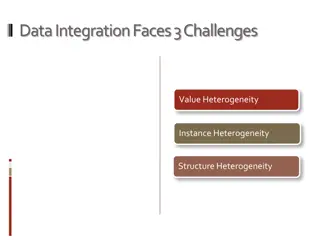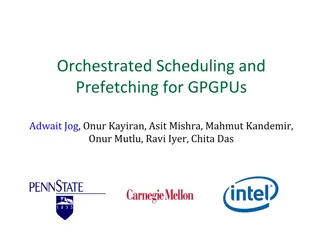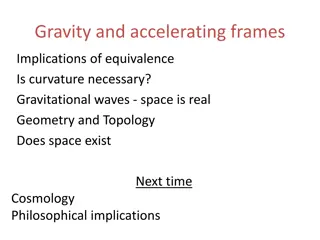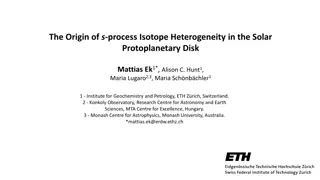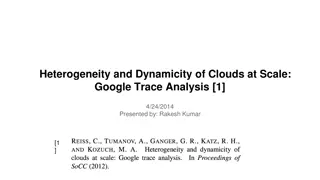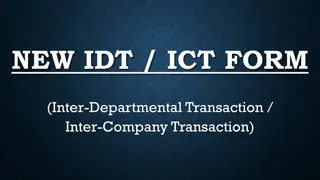Enhancing GPGPU Performance through Inter-Warp Heterogeneity Exploitation
This research focuses on addressing memory divergence issues in GPGPUs by exploiting inter-warp heterogeneity. By prioritizing mostly-hit warps and deprioritizing mostly-miss warps through Memory Divergence Correction (MeDiC), significant performance and energy efficiency improvements were achieved compared to traditional caching policies. Key observations, solutions, and results are highlighted, emphasizing the stable nature of divergence characteristics over time.
Download Presentation

Please find below an Image/Link to download the presentation.
The content on the website is provided AS IS for your information and personal use only. It may not be sold, licensed, or shared on other websites without obtaining consent from the author.If you encounter any issues during the download, it is possible that the publisher has removed the file from their server.
You are allowed to download the files provided on this website for personal or commercial use, subject to the condition that they are used lawfully. All files are the property of their respective owners.
The content on the website is provided AS IS for your information and personal use only. It may not be sold, licensed, or shared on other websites without obtaining consent from the author.
E N D
Presentation Transcript
Exploiting Inter-Warp Heterogeneity to Improve GPGPU Performance Rachata Ausavarungnirun Saugata Ghose, Onur Kayiran, Gabriel H. Loh Chita Das, Mahmut Kandemir, Onur Mutlu
Overview of This Talk Problem: memory divergence Threads execute in lockstep, but not all threads hit in the cache A single long latency thread can stall an entire warp Key Observations: Memory divergence characteristic differs across warps Some warps mostly hit in the cache, some mostly miss Divergence characteristic is stable over time L2 queuing exacerbates memory divergence problem Our Solution: Memory Divergence Correction Uses cache bypassing, cache insertion and memory scheduling to prioritize mostly-hit warps and deprioritize mostly-miss warps Key Results: 21.8% better performance and 20.1% better energy efficiency compared to state-of-the-art caching policy on GPU 2
Outline Background Key Observations Memory Divergence Correction (MeDiC) Results 3
Latency Hiding in GPGPU Execution GPU Core Status Time Warp A Warp B Active Warp C Warp D Lockstep Execution Thread Stall Active GPU Core 4
Problem: Memory Divergence Warp A Cache Hit Stall Time Time Main Memory Cache Miss Cache Hit 5
Outline Background Key Observations Memory Divergence Correction (MeDiC) Results 6
Observation 1: Divergence Heterogeneity Mostly-hit warp All-hit warp Mostly-miss warp All-miss warp Reduced Stall Time Time Key Idea: Convert mostly-hit warps to all-hit warps Convert mostly-miss warps to all-miss warps Cache Miss Cache Hit 7
Observation 2: Stable Divergence Char. Warp retains its hit ratio during a program phase Hit ratio number of hits / number of access 8
Observation 2: Stable Divergence Char. Warp retains its hit ratio during a program phase Warp 1 Warp 2 Warp 3 Warp 4 Warp 5 Warp 6 1.0 0.9 Mostly-hit 0.8 0.7 Hit Ratio 0.6 0.5 Balanced 0.4 0.3 0.2 0.1 Mostly-miss 0.0 Cycles 9
Observation 3: Queuing at L2 Banks Request Buffers Bank 0 Bank 1 Bank 2 To Memory Scheduler DRAM Bank n Shared L2 Cache 45% of requests stall 20+ cycles at the L2 queue Long queuing delays exacerbate the effect of memory divergence 10
Outline Background Key Observations Memory Divergence Correction (MeDiC) Results 11
Our Solution: MeDiC Key Ideas: Convert mostly-hit warps to all-hit warps Convert mostly-miss warps to all-miss warps Reduce L2 queuing latency Prioritize mostly-hit warps at the memory Maintain memory bandwidth 12
Memory Divergence Correction Warp-type-aware Cache Bypassing Mostly-miss, All-miss Bank 0 Warp Type Identification Logic Bank 1 Low Priority Bypassing Logic N Bank 2 Memory Request High Priority To Y DRAM Bank n Any Requests in High Priority Shared L2 Cache Warp-type-aware Memory Scheduler Memory Scheduler Warp-type-aware Cache Insertion Policy 13
Mechanism to Identify Warp Type Profile hit ratio for each warp Group warp into one of five categories All-hit Mostly-hit Balanced Mostly-miss All-miss Higher Priority Lower Priority Periodically reset warp-type 14
Warp-type-aware Cache Bypassing Warp-type-aware Cache Bypassing Mostly-miss, All-miss Bank 0 Warp Type Identification Logic Bank 1 Low Priority Bypassing Logic N Bank 2 Memory Request High Priority To Y DRAM Bank n Any Requests in High Priority Shared L2 Cache Warp-type-aware Memory Scheduler Warp-type-aware Cache Insertion Policy 15
Warp-type-aware Cache Bypassing Goal: Convert mostly-hit warps to all-hit warps Convert mostly-miss warps to all-miss warps Our Solution: All-miss and mostly-miss warps Bypass L2 Adjust how we identify warps to maintain miss rate Key Benefits: More all-hit warps Reduce queuing latency for all warps 16
Warp-type-aware Cache Insertion Warp-type-aware Cache Bypassing Mostly-miss, All-miss Bank 0 Warp Type Identification Logic Bank 1 Low Priority Bypassing Logic N Bank 2 Memory Request High Priority To Y DRAM Bank n Any Requests in High Priority Shared L2 Cache Warp-type-aware Memory Scheduler Warp-type-aware Cache Insertion Policy 17
Warp-type-aware Cache Insertion Goal: Utilize the cache well Prioritize mostly-hit warps Maintain blocks with high reuse Our Solution: All-miss and mostly-miss Insert at LRU All-hit, mostly-hit and balanced Insert at MRU Benefits: All-hit and mostly-hit are less likely to be evicted Heavily reused cache blocks from mostly-miss are likely to remain in the cache 18
Warp-type-aware Memory Sched. Warp-type-aware Cache Bypassing Mostly-miss, All-miss Bank 0 Warp Type Identification Logic Bank 1 Low Priority Bypassing Logic N Bank 2 Memory Request High Priority To Y DRAM Bank n Any Requests in High Priority Shared L2 Cache Warp-type-aware Memory Scheduler Warp-type-aware Cache Insertion Policy 19
Not All Blocks Can Be Cached Despite best efforts, accesses from mostly-hit warps can still miss in the cache Compulsory misses Cache thrashing Solution: Warp-type-aware memory scheduler 20
Warp-type-aware Memory Sched. Goal: Prioritize mostly-hit over mostly-miss Mechanism: Two memory request queues High-priority all-hit and mostly-hit Low-priority balanced, mostly-miss and all-miss Benefits: Mostly-hit warps stall less 21
MeDiC: Example Mostly-miss Warp All-miss Warp Bypass Cache Cache Queuing Latency Lower queuing latency DRAM Queuing Latency Insert at LRU Cache/Mem Latency All-hit Warp Mostly-hit Warp High Priority Insert at MRU Lower stall time 22
Outline Background Key Observations Memory Divergence Correction (MeDiC) Results 23
Methodology Modified GPGPU-Sim modeling GTX480 15 GPU cores 6 memory partition 16KB 4-way L1, 768KB 16-way L2 Model L2 queue and L2 queuing latency 1674 MHz GDDR5 Workloads from CUDA-SDK, Rodinia, Mars and Lonestar suites 24
Comparison Points FR-FCFS baseline [Rixner+, ISCA 00] Cache Insertion: EAF [Seshadri+, PACT 12] Tracks blocks that are recently evicted to detect high reuse and inserts them at the MRU position Does not take divergence heterogeneity into account Does not lower queuing latency Cache Bypassing: PCAL [Li+, HPCA 15] Uses tokens to limit number of warps that gets to access the L2 cache Lower cache thrashing Warps with highly reuse access gets more priority Does not take divergence heterogeneity into account PC-based and Random bypassing policy 25
Results: Performance of MeDiC Baseline EAF PCAL MeDiC 2.5 Speedup Over Baseline 2.0 21.8% 1.5 1.0 0.5 MeDiC is effective in identifying warp-type and taking advantage of divergence heterogeneity 26
Results: Energy Efficiency of MeDiC Baseline EAF PCAL MeDiC 4.0 Norm. Energy Efficiency 3.5 3.0 2.5 2.0 20.1% 1.5 1.0 0.5 Performance improvement outweighs the additional energy from extra cache misses 27
Other Results in the Paper Breakdowns of each component of MeDiC Each component is effective Comparison against PC-based and random cache bypassing policy MeDiC provides better performance Analysis of combining MeDiC+reuse mechanism MeDiC is effective in caching highly-reused blocks Sensitivity analysis of each individual components Minimal impact on L2 miss rate Minimal impact on row buffer locality Improved L2 queuing latency 28
Conclusion Problem: memory divergence Threads execute in lockstep, but not all threads hit in the cache A single long latency thread can stall an entire warp Key Observations: Memory divergence characteristic differs across warps Some warps mostly hit in the cache, some mostly miss Divergence characteristic is stable over time L2 queuing exacerbates memory divergence problem Our Solution: Memory Divergence Correction Uses cache bypassing, cache insertion and memory scheduling to prioritize mostly-hit warps and deprioritize mostly-miss warps Key Results: 21.8% better performance and 20.1% better energy efficiency compared to state-of-the-art caching policy on GPU 29
Exploiting Inter-Warp Heterogeneity to Improve GPGPU Performance Rachata Ausavarungnirun Saugata Ghose, Onur Kayiran, Gabriel H. Loh Chita Das, Mahmut Kandemir, Onur Mutlu
Queuing at L2 Banks: Real Workloads 53.8% 16% Fract. of L2 Requests 14% 12% 10% 8% 6% 4% 2% 0% Queuing Time (cycles) 32
Adding More Banks 1.6 Normalized Performance 12 Banks 2 Ports 24 Banks 4 Ports 24 Banks 2 Ports 48 Banks 2 Ports 1.4 1.2 5% 1.0 0.8 0.6 0.4 0.2 0.0 33
Queuing Latency Reduction 40 88.5 Baseline Queuing Latency (cycles) 35 WByp 30 MeDiC 25 20 69.8% 15 10 5 0 34
MeDiC: Performance Breakdown WIP WMS WByp MeDiC 2.5 Speedup Over Baseline 2.0 1.5 1.0 0.5 35
MeDiC: Miss Rate 1.0 Baseline Rand 0.8 L2 Cache Miss Rate WIP MeDiC 0.6 0.4 0.2 0.0 36
MeDiC: Row Buffer Hit Rate 1.0 Baseline WMS MeDiC 0.9 Row Buffer Hit Rate 0.8 0.7 0.6 0.5 0.4 37
MeDiC-Reuse 2.4 2.2 MeDiC MeDiC-reuse Speedup Over Baseline 2.0 1.8 1.6 1.4 1.2 1.0 0.8 38
L2 Queuing Penalty 350 1,000 Avg. Penalty from Divergence Max. Penalty from Divergence 900 L2 L2 300 800 250 700 L2 + DRAM L2 + DRAM 600 200 500 150 400 100 300 200 50 100 0 0 SCP IIX BFS BP SS DMR SC BH CONS MST NN HS SSSP PVC PVR SCP NN DMR BP IIX SS SC BH BFS CONS MST PVC HS PVR SSSP 39
Stable Divergence Characteristics Warp retains its hit ratio during a program phase Heterogeneity Control Divergence Memory Divergence Edge cases on the data the program is operating on Coalescing Affinity to different memory partition Stability Temporal + spatial locality 42
Warps Can Fetch Data for Others All-miss and mostly-miss warps can fetch cache blocks for other warps Blocks with high reuse Shared address with all-hit and mostly-hit warps Solution: Warp-type aware cache insertion 43
Warp-type Aware Cache Insertion Future Cache Requests A1 A2 LRU MRU LRU MRU A7 A9 B3 A8 B2 A3 A4 LRU MRU LRU B1 A5 A6 B2 MRU L2 Cache 44
Warp-type Aware Memory Sched. Memory Request Warp Type All-hit, Mostly-hit Balanced, Mostly-miss, All-miss High Priority Queue Memory Request Queue Low Priority Queue Memory Scheduler FR-FCFS Scheduler FR-FCFS Scheduler Main Memory 45
